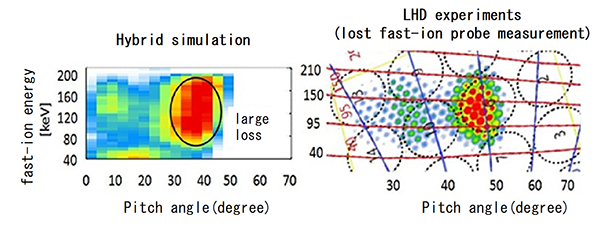HOME > Research Activities > Research Updates >
Comparative research of hybrid simulation with experiments
To achieve fusion power, it is necessary to heat plasma to a high temperature of more than one hundred million degrees so that the fusion reaction continues. In the Large Helical Device (LHD), the plasma is heated by fast ions with higher energy than the average energy of plasma particles. Hydrogen and deuterium beams accelerated by high voltage are launched into the plasma and the fast ions are generated. The plasma is heated by the energy of the generated fast ions. In a future fusion reactor, fast helium ions generated by fusion reactions will heat the plasma and maintain the high temperature required to sustain the fusion reaction. For the establishment of the method of efficient heating the plasma, it is necessary to predict the behavior of fast ions with high precision. This time, we will introduce comparative research between computer simulations and the LHD experiments.
Fast ions gyrating in the doughnut plasma confined by the magnetic fields heat the plasma. The behaviors of these fast ions are significantly influenced by plasma oscillations. Plasma is a group of many charged particles. In the air which is a group of many molecules oscillations transmit sound. As in the air, various oscillations occur in the plasma. When the frequency of such plasma oscillations is equal to the gyration cycle of the fast ions in the plasma, resonance between the oscillations and the fast ions can occur and the oscillations can become large. When the fast ions jump out of the plasma by the influences of the large oscillations, the heating efficiency of the plasma decreases. Accordingly, in order to predict the behaviors of the fast ions and to establish an efficient method for heating plasma, it is necessary to clarify the interaction between the plasma oscillations and the fast ions.
The National Institute for Fusion Science, in order to clarify the interaction between such plasma oscillations and the fast ions, has been developing a program called "hybrid simulation" that calculates by connecting the plasma dynamics and the motion of the fast ions. (For details, please refer to back number 282) It is necessary to confirm whether the simulation can reproduce the experimental results to confirm the reliability of the simulation. The hybrid simulation succeeds in reproducing the plasma oscillations caused by the fast ions observed in the LHD and in the experimental devices in the United States.
The LHD experimental results also show that the fast ions are influenced by the plasma oscillations and are jumped out from the plasma. This time, we focused on whether these experimental results of the LHD can be reproduced by the hybrid simulation. In the LHD, a measuring instrument called a lost fast ion probe has been installed to measure the energy and the quantity of the fast ions lost from the plasma. In addition, by taking this energy and the characteristics of the ions gyrating around the magnetic field lines into consideration, we can calculate the velocity components of the lost fast ions (the gyration speed and the velocity in the direction of the magnetic field lines).
In order to compare with the measuring results in the LHD, we set the same conditions as the experiments for the temperature and the density of the plasma, the velocity and the distribution of the fast ions, and performed a simulation to reproduce the plasma oscillations.
In addition, we made a detailed analysis of the relationship between these oscillations and the fast ions. We succeeded in showing that the fast ions are lost when the oscillation become large, and that the amount of the lost fast ions is proportional to the square of the magnitude of the oscillations. These simulation results are similar to the experimental results. Also, we almost reproduced the measured data of the LHD experiments with respect to the energy and the velocity components of the lost fast ions. As a result of these comparisons between the simulations and the LHD experiments, we have succeeded in further improvement of the reliability of the hybrid simulation.
In future, by promoting research in comparison of the hybrid simulation and the LHD experiments, we will improve the prediction precision of fast-ions behaviors in a future fusion reactor.

Figure: Comparison of a hybrid simulation and the LHD experiments with respect to fast hydrogen ions lost from the plasma. A vertical axis shows the energy of fast hydrogen ions and 100keV means the velocity of approximately 4,000 km/s. A horizontal axis shows a pitch angle which shows the ratio of the gyration speed and the velocity along the magnetic fields. The colors of the figure show the number of the lost fast ions (decreasing in the order of red, yellow, and blue). If you look at the red part which shows that the loss is high, that part shows an agreement between the simulation and the experiments.
